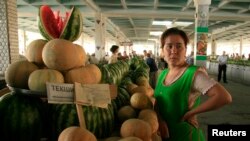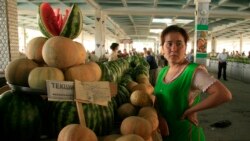The United States is continuing to promote regional economic cooperation between Central and South Asia through the New Silk Road initiative.
In a recent Foreign Policy editorial U.S. Deputy Assistant Secretary of State for South and Central Asian Affairs Fatema Sumar wrote that “Afghanistan, has made tremendous strides over the past 12 years.”
Afghanistan and its neighbors now have the opportunity to increase their cooperation and enhance their security and stability through regional energy markets, trade and transport routes, improved customs and borders, and connecting businesses and people.
With a population of 1.6 billion people, South Asia's demand for energy is growing. At the same time, Central Asia is a repository of vast energy resources, including oil, gas, and hydropower. To help create a regional energy market, the U.S. is supporting multiple projects including the World Bank's CASA-1000, an electricity transmission line that will enable Tajikistan and Kyrgyzstan to supply 1,300 megawatts of surplus summer hydropower to Afghanistan and Pakistan.
Trade and transport remain critical to the Silk Road vision. That's why the U.S. is focused on improving the legal and regulatory frameworks and removing impediments to trade and investment. The average cost of crossing borders in Central Asia has dropped 15 percent in the last three years, and the volume of intra-regional trade has increased by 49 percent over the last five years. But much more needs to be done to unlock the potential trade and investment opportunities.
Beyond infrastructure, the U.S. vision also seeks to promote greater regional economic integration through people-to-people connections. In February 2014, over 250 Afghan, Kazakhstani, and Uzbekistani businesspeople gathered in Mazar-i-Sharif, near the Friendship Bridge, signing over $8 million in letters of intent for commercial sales. And the U.S. is funding the studies of hundreds of Central Asian and Afghan students, including women, to build the next generation of regional leaders and businesspeople.
“The "New Silk Road" should not be viewed as a "zero sum game," said Deputy Assistant Secretary Sumar, “but as a necessary process for the independence and economic development of the region. Indeed, new North-South transit and trade routes linking Central and South Asia can complement growing East-West connections across Eurasia, including those pursued by China and Russia.”
“These commitments show the desire by people in the region to look past historical differences and to a future of regional economic connectivity that can increase prosperity and stability.”
In a recent Foreign Policy editorial U.S. Deputy Assistant Secretary of State for South and Central Asian Affairs Fatema Sumar wrote that “Afghanistan, has made tremendous strides over the past 12 years.”
Afghanistan and its neighbors now have the opportunity to increase their cooperation and enhance their security and stability through regional energy markets, trade and transport routes, improved customs and borders, and connecting businesses and people.
With a population of 1.6 billion people, South Asia's demand for energy is growing. At the same time, Central Asia is a repository of vast energy resources, including oil, gas, and hydropower. To help create a regional energy market, the U.S. is supporting multiple projects including the World Bank's CASA-1000, an electricity transmission line that will enable Tajikistan and Kyrgyzstan to supply 1,300 megawatts of surplus summer hydropower to Afghanistan and Pakistan.
Trade and transport remain critical to the Silk Road vision. That's why the U.S. is focused on improving the legal and regulatory frameworks and removing impediments to trade and investment. The average cost of crossing borders in Central Asia has dropped 15 percent in the last three years, and the volume of intra-regional trade has increased by 49 percent over the last five years. But much more needs to be done to unlock the potential trade and investment opportunities.
Beyond infrastructure, the U.S. vision also seeks to promote greater regional economic integration through people-to-people connections. In February 2014, over 250 Afghan, Kazakhstani, and Uzbekistani businesspeople gathered in Mazar-i-Sharif, near the Friendship Bridge, signing over $8 million in letters of intent for commercial sales. And the U.S. is funding the studies of hundreds of Central Asian and Afghan students, including women, to build the next generation of regional leaders and businesspeople.
“The "New Silk Road" should not be viewed as a "zero sum game," said Deputy Assistant Secretary Sumar, “but as a necessary process for the independence and economic development of the region. Indeed, new North-South transit and trade routes linking Central and South Asia can complement growing East-West connections across Eurasia, including those pursued by China and Russia.”
“These commitments show the desire by people in the region to look past historical differences and to a future of regional economic connectivity that can increase prosperity and stability.”

















